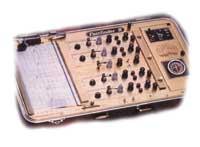Polygraph incidents
Elhuyar Fundazioa
Scientific foundations of polygraph
The polygraph is a device that records on paper or on screen changes of certain physiological parameters of the person. Data is collected by in-person sensors. To measure tension, the “belts” that surround the chest (to measure breathing movements) and especially the digital electrodes (to measure sweat) are placed in the body of the person to whom the test is to be performed.
What makes the polygraph an interesting device is to record skin reactions. The electrical activity of the surface, called electrodermal, is one of the best exponents of emotions. Our body is continuously subjected to two components of the nervous system, one sympathetic and another parasympathetic, which cannot be dominated by the will of the person. These two opposing components regulate most of our organs.

Any attack, fear, emotion, etc., immediately excites the sympathetic nervous system. Therefore, among other things, the heart gives more heartbeat, breathing accelerates, etc. This system mainly causes the discharge of the sweat glands, although there are two types of sweat glands: the apocrine glands and the ecrine glands that intervene in any thermoregulation process. The latter are under the hands and under the feet and are only activated with emotions. Therefore, they are very interesting for the polygraph.
There are several methods to measure the activity of the ecrine glands. One of them, developed in England, is based on measuring the production of tanttas in the nasal canals. The volume of sweat is proportional to the activity of the gland. Another system is international and is known by conductivity measuring electrodermal activity. Two electrodes are placed on the fingers and the electric microcurrent is passed on the surface. The current is easier when there is sweat on the surface.
Session questions
The conversation between the polygraph handler and the person being analyzed ranges from two to four hours. The full conversation is rolled and recorded. In the first phase called Pretest, the examiner explains the procedure to the person who will give the answers. He then explains all the questions he will ask in the test. Everything that is done or said in the test is done and said before.
Ten closed questions are prepared. Some are neutral and serve to evaluate physiological traces (today is Friday?) and asked to answer similar questions or not. Other questions aim to measure the value of the person (“Do you fear that I will ask you any questions that I have not yet asked?”, “Do you plan to answer all questions the truth?”, etc. These are). Finally, other issues are complaints (whether or not). Once the test is done, the data are analyzed and the results are communicated to the data subject.
Polygraph uses
Although the results of the polygraphs do not serve as evidence in the courts, in Belgium it has been used recently. In Brabant 28 people and dozens of wounded died between 1982 and 1985, but the judges had no trace of criminals. Fifteen years later they have used new techniques: DNA analysis, statements under hypnosis and lie detector or polygraph.
18 suspects of the killings in Brabante and 12 implicated in some cases have been tested and the results have been satisfactory. Two of the three positive test suspects are found guilty. But three other lie detectors, considered guilty, are not and do not expect to leave prison on provisional release.
But for this there is an obstacle: Unlike DNA analysis, the results offered by the polygraph cannot be used as evidence in the courts. However, the statements obtained on the test once the test is finished can be used. In the Belgian experience it has been observed that thirty percent of the tested lie and then eighty-five percent of them make statements about the results.
Polygraph users

Most current technicians capable of using the polygraph are in the United States and Canada. They are about a thousand two hundred in total and above all murders, kidnappings, etc. have to clarify or work for insurers. All who now do have studied in the United States, but have begun to prepare the new school in Québec.
In addition to working for the courts, they also work for private companies, often to test those who have to hire. To do this, a 1988 law set limits in the United States to prevent abuse. Therefore, the polygraph test cannot be asked questions about their religious, sexual or political ideas.
Outside North America, the polygraph is also frequently used in Russia, Eastern European States, Germany, United Kingdom and Israel. In Russia they use it in the company Media-Most and use it legally. They say that the goal of using the polygraph is for participating companies to know which companies demand work confidentially.
They use the polygraph to verify that Israel's officials and politicians are honest. In the UK, especially for the clarification of sexual murders or in private companies.





